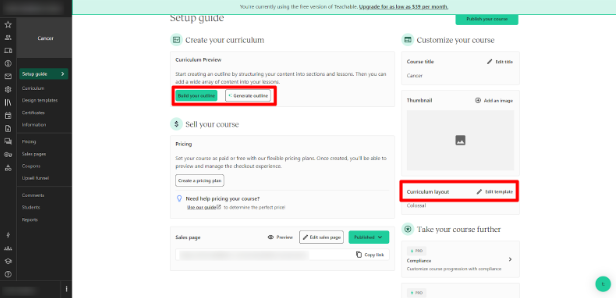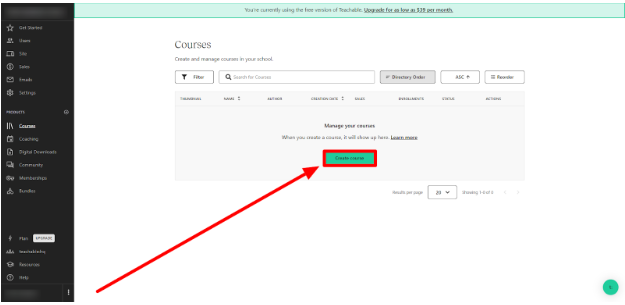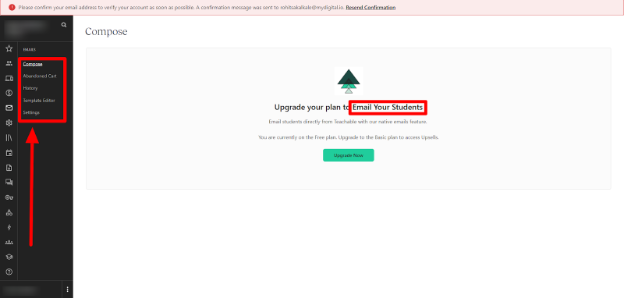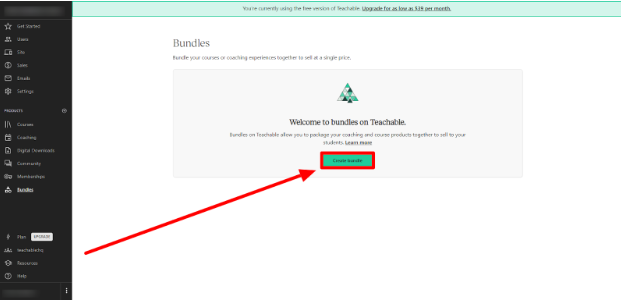Launching an online course is the best way for teachers to expand their reach and influence digitally. Online courses allow teachers to share their knowledge with a global audience and provide students with an accessible learning opportunity.
As an online course instructor with my own courses, I have firsthand experience creating and launching successful online courses.
In this article, you’ll learn the important steps to follow while creating an online course and some additional tips. I will also share my insights, strategies, and preferences to help you launch your online course effectively.
What are you waiting for? Let’s get going!
How To Launch An Online Course: A Quick Checklist
- Choose a topic you’re passionate about, and make sure it meets high demand and fills a niche.
- Understand your target audience’s needs and goals through keyword research, surveys, and social media engagement.
- Develop measurable learning objectives to guide your course content and assessments.
- Layout your course structure, create engaging content formats, and make sure at least 20% of the content is ready before launch.
- Build excitement through email lists, social media, webinars, and collaborations, and offer discounts on launch day.
8 Steps Teachers Can Use To Launch An Online Course
It is a myth that teaching online is somehow easier than face-to-face instruction. That being said, every method of delivery has its challenges. But, there is a lot of scope in digital learning, and the online education market is projected to be worth $120.7 billion in 2024.
The most troublesome challenge in online teaching is launching online courses. Here are the eight most important steps to launch an online course.
1. Define Your Passion And Skills
Skill is really worthless unless you back it up with passion. It is the same with online courses. Your online course topic does not have to be something you love, but you should be passionate about it. It is because your passion for the subject will automatically translate into your content.
This will put you in a better position to inspire and engage your audience while making your course more authentic and relatable. Consider your educational background, practical industry skills, and knowledge to choose a topic in which you excel.
Choose the topic you’re uniquely suited to teach, where you have insight, credibility, expertise, and passion.
Also, ensure that the course topic is in high market demand. While choosing your topic and creating content, consider the competition and identify a niche you can fill.
2. Identify Your Audience + Finalize Course Ideas
When launching a course, it is crucial to identify your target audience. This step helps you understand your potential customers, what they need, and what they are willing to pay for.
Here are some key points to consider when identifying your audience:
A. Identify Your Audience and Their Goals:
Identify the people who are most likely to be interested in your course and what they want to achieve. This will help you tailor your course content and marketing strategy to meet their needs.
You can also use keyword research to identify what people are searching for online. Similarly, an audience survey should be conducted to gather feedback and understand what people want to learn. I’ll also advise you to utilize social media to engage with your target audience and understand their needs.
B. Brainstorm Course Ideas:
When launching an online course, it’s essential to brainstorm ideas that resonate with your target audience and solve a specific problem or fill a particular need. Encourage students to consider your unique skills, passions, and experiences.
Ask yourself questions like:
- What are the most common questions I get asked about this topic?
- What are the biggest pain points my audience faces?
- What are the most significant benefits I can offer to my audience?
C. Validate Course Ideas:
Research the demand for similar courses and identify potential competitors. Analyze their offering, pricing, and marketing strategies to understand what works and what doesn’t.
If your blog posts generate significant traffic and engagement, it is a good sign that an audience is interested in this topic. You can also reach out to potential students and ask about their pain points, interest, and willingness to pay for a course on the topic.
You can also pilot-test your course idea with a small group of students to gather feedback and refine your content. Ensure the chosen topic aligns with the audience’s needs and interests.
Note: You can use tools like Marketplace Insights to identify in-demand topics.
3. Define The Learning Objectives
It is necessary to define the learning objectives that will guide the course content and assessment development. The learning objective serves as a roadmap for the course, helping to ensure that the content is compelling, engaging, and relevant in achieving the desired outcome.
- Craft Clear Learning Objectives
To craft a learning objective, determine the overall goal of the course. Break down that goal into Specific, Measurable, Achievable, Relevant, and Time-bound (SMART) objectives. Avoid vague or open-ended objectives; ensure they are clear, concise, and measurable.
You must ensure that the learning objectives are relevant to your learners’ needs and achievable based on their prior knowledge and skills.
4. Plan Your Course Content
Remember, your course content sets the foundation for a successful course. You already have a course idea by this time. Some platforms like Teachable have inbuilt options that help you create an outline and plan your course material.

Decide on your course format: video, text-based, interactive, or a combination. Create top-tiered content that is informative, engaging, and relevant to your audience. You can start your online course with Teachable for free, and if you want the premium features, then use the coupons from Teach.coupons website to buy a subscription to Teachable at an affordable price.
5. Create The Course Content
Now that you have planned your course content, move on to its creation.
A. Develop a Well-Structured Course Outline:
You need to plan the overall structure of your course, including the number of modules, lessons, and topics. For that, create a layout to organize your content and break down each topic into smaller, manageable chunks.
It is best if you create a list of particular learning objectives for each topic. This is how I created course content too.

With Teachable, you get numerous options to structure the course content. While developing a course, make sure there is a logical content progression.
B. Content Creation:
You have to develop interactive content, such as quizzes, assignments, and coding exercises. Do not neglect to use a variety of content formats, such as text, audio, and images. Before starting the course, you should have at least 20% of the content ready.
6. Choose A Platform For Your Online Courses
Choosing the right platform is very important. You should look for a user-friendly and easy-to-navigate platform, even if you are not tech-savvy.
Selecting the Right Platform:
I have searched for the most popular platforms to host your courses to make your journey more trouble-free. Here are some top online course platforms that you may want to consider:
| Features | Udemy | Teachable | Skillshare | Thinkific |
|---|---|---|---|---|
| Price | $20/month onwards | $39/month onwards | $32/month onwards | $36/month onwards |
| Free Trial | ✔️ | Free plan | 7-day | 14-day |
| Easy to use | ✔️ | ✔️ | ✔️ | ✔️ |
| Large student base | ✔️ | ✔️ | ✔️ | ✔️ |
| Customization | ✔️ | ✔️ | ❌ | ✔️ |
| Projects assignments | ✔️ | ✔️ | ✔️ | ✔️ |
| Quizzes | ✔️ | ✔️ | ❌ | ✔️ |
| AI assistance | ✔️ | ✔️ | ❌ | ✔️ |
| Classes | 220,000+ | 500,000+ | 25,000+ | 100,000+ |
| Members | 70 million+ | 18 million+ | 600,000+ | 800,000+ |
| Teachers | N/A | 100,000+ | 8000+ | 50,000+ |
| Ratings* | 4.5/5 | 4/5 | 3.3/5 | 4.6/5 |
*Note: These ratings have been sourced from G2.
Personally, visit every site given in the table and search for the features you think are suitable for your course. Make a decision based on what you want to deliver and what your students want to listen to.
7. Brainstorm And Implement Pre-Launch Strategies
Before launching an online course, developing a solid pre-launch strategy is essential to create buzz, build excitement, and make sales. Here are some effective pre-launch strategies you can consider:
For that, list potential students interested in your course topic. The email listing allows you to target a particular audience.
By building a healthy relationship with your audience through email, you can instill trust and credibility, making them more likely to purchase your course.

Online course hosting platforms like Teachable have email listing options, too. You don’t need to use a separate application or program for email listing.
In addition to email listing, you can leverage other social media platforms to promote your courses, engage with your audience, and build anticipation. You can also create valuable content, such as blog posts, videos, and podcasts, to attract potential students and establish your authority in the niche.
You should host webinars, live events, or Q&A sessions and collaborate with influencers frequently to reach a wider audience and build credibility.
8. Launch The Course
Set a launch date and create a countdown to build anticipation. Since you have already sent pre-launch emails to subscribers and promoted the course on social media, launching a course remains the sole priority now.
To attract students, offer discounts and bonuses; this will incentivize people to purchase your course on the launch day. You can also offer a limited-time discount on your course with Teachable.

Some platforms, like Teachable, offer the option of bundling courses before and after their launch. Bundling courses helps teachers streamline content creation, improve student engagement, and increase revenue. However, it helps students differently; by accessing bundled courses, students can get clear, structured courses at a low cost.
10 Additional Tips To Launch A Successful Online Course
The steps I mentioned above are just the tip of the iceberg. Here are some additional tips that will help you launch an online course and gain positive traction.
1. Engage Early Adopters and Gather Testimonials: Offer early access to a select group of students in exchange for feedback and testimonials.
2. Leverage Content Marketing: Write informative blog posts, create short videos or trailers highlighting your course’s key aspects, and share them on YouTube and social media.
3. Utilize Email Marketing: Set up a series of automated emails to nurture your audience, provide valuable content, and gradually introduce your course.
4. Optimize Your Course Landing Page: Use strong Call-To-Actions to guide visitors toward enrolling in your course. Ensure the enrollment process is smooth and user-friendly.
5. Implement a Pricing Strategy: Offer multiple pricing tiers with varying access levels or additional resources to cater to different budget levels. Create a sense of priority with limited-time discounts or bonuses to encourage quick enrollment.
6. Utilize SEO Strategies: Optimize your course title, description, and landing page content with relevant keywords to improve search engine visibility. Obtain backlinks from reputable websites and blogs in your niche to boost your course’s search engine ranking.
7. Create a Community: Create a dedicated discussion forum or community group where students can interact, share ideas, and support each other.
8. Monitor and Adjust Your Marketing Strategies: Use online analytics tools to track key parameters such as website traffic, conversion rates, and student engagement and continuously gather student feedback.
9. Offer Post-Launch Support and Updates: Frequently update your content and provide a support system to assist students with any questions or issues.
10. Expand Your Course Offerings: Develop supplementary courses or advanced modules that complement your main course to prevent student churning. Create course bundles at a discounted rate to provide more value to your students and increase sales.
By incorporating these additional tips, you can enhance the effectiveness of your online course launch and create a more engaging and successful learning experience for your students.
Conclusion: Teachable Is The Best Platform To Launch An Online Course!
Launching an online course requires careful planning and perfect execution. You must do everything with diligence, from defining your passion and skills to creating engaging content and selecting the right platform.
By following these eight steps mentioned in the article, you can effectively share your expertise and engage a global audience.
After exploring various options, I found that Teachable is the best platform for launching your online course. Its user-friendly interface and advanced features make it ideal for beginners and experienced teachers alike.
So start your course today with Teachable, and turn your knowledge into an educational venture!
FAQs
To launch your course, you first need to build your audience, then plan and prepare, create engaging content, and launch the course on the right platform.
Choose the Elearning management system, prepare your material, and set up your online classroom. By following these steps, you’ll be well on your way to successfully teaching lessons online.
Create and sell online courses by choosing a passionate, in-demand topic, identifying your audience, planning engaging content, selecting a suitable platform like Teachable, and employing effective pre-launch, launch, and post-launch strategies.
It is impossible to predict the exact time to create an online course, as it depends on various factors, including the subject matter, audience, and LMS provider.

